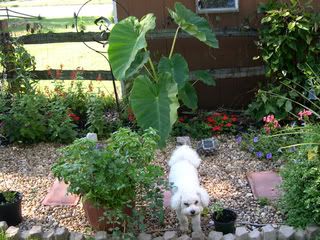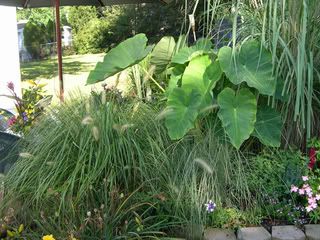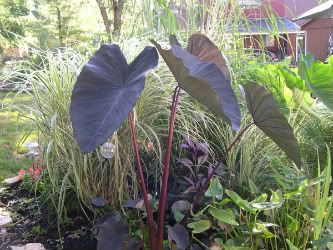Giant Elephant Ears
Well, I'm a little late this year, but better late than never.
I'm referring to my Giant Elephant Ear bulbs. I just put them in the ground yesterday. They're supposed to be planted after threat of frost has passed, so with the way things were this past week, I don't think I'm too far off the mark.
Pictured here from last summer (with Lexie), Elephant Ear plants are a big, leafy member of the Caladium family. And I'm talking BIG, leaves as big as an elephant's ear, hence the name. And the colorful leaves have a shape resembling an elephant's ear, too.
Gardeners are fascinated by this big-leaved plant that grows 3-5 ft. tall. Originating in tropical and sub-tropical areas, they love sunshine, heat and high humidity. They are easy to grow and will grow in sun or shade. However, I found out last year that they don't grow nearly as well or as high in shaded areas. I primarily bought them for shade, because that's what the ticket on them said they liked, only to find the one single bulb that got sun was absolutely spectacular, as seen here.
Elephant Ears are grown from tuberous bulbs, resembling some kind of prehistoric egg. In our Zone (6), after the plants have died back in the fall, the bulbs must be dug up. Clean and store them in a cool, dark area until planting the following spring.
They can also be grown in large, heavy pots for ease in storing. Pots must be heavy to shoulder the weight of the huge leaves. I absolutely love them! I got my bulbs at Home Depot last spring. They cost $5 per bulb, but they were worth it!
Also don't overlook their close cousin the Black Taro bulb. I like to grow it every year in the pond. This is the first year that I was actually able to winter-over the bulb indoors. Good thing too, because as you can see here, it was awesome last year!

Note: These plants can be poisonous to children and pets. However, the Black Taro doesn't harm the fish.
Up next, our good friend, the Clematis!
I'm referring to my Giant Elephant Ear bulbs. I just put them in the ground yesterday. They're supposed to be planted after threat of frost has passed, so with the way things were this past week, I don't think I'm too far off the mark.

Pictured here from last summer (with Lexie), Elephant Ear plants are a big, leafy member of the Caladium family. And I'm talking BIG, leaves as big as an elephant's ear, hence the name. And the colorful leaves have a shape resembling an elephant's ear, too.
Gardeners are fascinated by this big-leaved plant that grows 3-5 ft. tall. Originating in tropical and sub-tropical areas, they love sunshine, heat and high humidity. They are easy to grow and will grow in sun or shade. However, I found out last year that they don't grow nearly as well or as high in shaded areas. I primarily bought them for shade, because that's what the ticket on them said they liked, only to find the one single bulb that got sun was absolutely spectacular, as seen here.

Elephant Ears are grown from tuberous bulbs, resembling some kind of prehistoric egg. In our Zone (6), after the plants have died back in the fall, the bulbs must be dug up. Clean and store them in a cool, dark area until planting the following spring.

They can also be grown in large, heavy pots for ease in storing. Pots must be heavy to shoulder the weight of the huge leaves. I absolutely love them! I got my bulbs at Home Depot last spring. They cost $5 per bulb, but they were worth it!
Also don't overlook their close cousin the Black Taro bulb. I like to grow it every year in the pond. This is the first year that I was actually able to winter-over the bulb indoors. Good thing too, because as you can see here, it was awesome last year!

Note: These plants can be poisonous to children and pets. However, the Black Taro doesn't harm the fish.
Up next, our good friend, the Clematis!
Labels: black taro, bulbs, Elephant Ears
 RSS
RSS



0 Comments:
Post a Comment
Links to this post:
Create a Link
<< Home